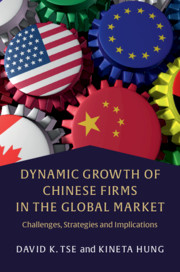Book contents
- Dynamic Growth of Chinese Firms in the Global Market
- Dynamic Growth of Chinese Firms in the Global Market
- Copyright page
- Contents
- Figures
- Tables
- 1 Introduction
- 2 China’s Economic Rise and Global Footprints of Chinese Firms
- 3 Globalisation of Chinese Firms Using Existing Paradigms
- 4 Globalisation of Chinese Firms Using New Paradigms
- 5 Challenges and Failures
- 6 Product Images and Market Acceptance of Chinese-Made Products
- 7 Corporate Social Responsibility
- 8 Managing National Image
- 9 China’s Technological Competence, Trade Relations, and Economic Co-operation
- 10 Holistic Conclusion through a Futuristic Lens
- Index
- References
3 - Globalisation of Chinese Firms Using Existing Paradigms
Published online by Cambridge University Press: 05 February 2020
- Dynamic Growth of Chinese Firms in the Global Market
- Dynamic Growth of Chinese Firms in the Global Market
- Copyright page
- Contents
- Figures
- Tables
- 1 Introduction
- 2 China’s Economic Rise and Global Footprints of Chinese Firms
- 3 Globalisation of Chinese Firms Using Existing Paradigms
- 4 Globalisation of Chinese Firms Using New Paradigms
- 5 Challenges and Failures
- 6 Product Images and Market Acceptance of Chinese-Made Products
- 7 Corporate Social Responsibility
- 8 Managing National Image
- 9 China’s Technological Competence, Trade Relations, and Economic Co-operation
- 10 Holistic Conclusion through a Futuristic Lens
- Index
- References
Summary
Dunning’s Globalisation (OLI) Model is the best known model of firm globalisation. It extends the cost-advantage perspective to include ownership, locational, and internationalisation advantages as determinants of a multinational corporations’ operation and growth. Using Haier as an exemplary firm, the chapter traces its revival from a non-performing SOE from China to becoming the top brand in home appliances as well as the OLI advantages it can leverage in the unique China context. The chapter also examines the National Development Globalisation Model, a model arising from China’s strong needs for energy and metals to fuel the country’s development and consumption, to address the globalisation of non-manufacturing firms. Using Chalco as an example, the chapter notes that, in spite of the firm’s lack of advantages, its ability to attract unwavering support from the government and its strong leadership to operate in the volatile global environment allow the firm to become the leading aluminium producer.
Keywords
- Type
- Chapter
- Information
- Dynamic Growth of Chinese Firms in the Global MarketChallenges, Strategies and Implications, pp. 31 - 52Publisher: Cambridge University PressPrint publication year: 2020



